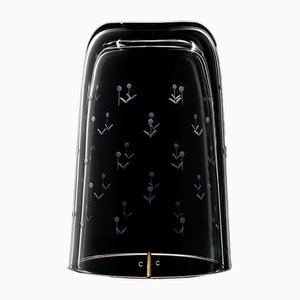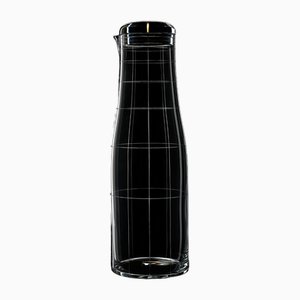At home with Vienna’s zerunianandweisz
The Rules of Attraction
The laws of chemistry and attraction are fuzzy. It’s hard to say exactly what draws one entity to another; and then, once together, what makes some combinations work so well, even sing, while others… not so much. In the case of Vienna’s zerunianandweisz, the former quite clearly applies. The unlikely pair has launched a rising-star design studio in Vienna. And each has created a curiously charming, wonderfully harmonious home brimming with an array of design objects sourced from disparate countries, eras, and movements.
The strong, individualistic styles championed by the cofounders of zerunianandweisz arose through decades of experience. Among other positions, Nadja Zerunian has served as the creative director for Georg Jensen and Swatch; Peter Weisz, meanwhile, has worked as a master tailor, fashion director, and stylist. Driven by their penchant for forging unconventional marriages, they’ve developed an aesthetic unlike anything else currently out there by combining found vintage pieces and new, handcrafted objects made in collaboration with traditional Roma craftspeople. The pair uses their design amalgamations to tell stories, and the resulting tales are frequently funny and enviably elegant.
As we recently found out, this same approach is evident in the way the two have decorated their homes. Zerunian’s “pied-a-terre-turned-permanent-residence” stands in Vienna’s epicenter, the Innere Stadt, where “the bells of the Cathedral wake us every morning.” Throughout her home, she has curated surprising combinations of flea market finds, keepsakes from her travels, and classic design pieces to create fabulous vignettes. In the living room alone, a Paola Navone Ghost Sofa and Marc Newson Orgone Table sit in conversation with a pair of anonymously designed midcentury wicker lounge chairs, all under the watchful guise of a vintage Mozambique initiation mask and custom floor-to-ceiling bookshelves created by Zerunian herself. Meanwhile, at Weisz’s home beside the famed Naschmarkt and the Karlskirche in Wieden, the city’s 4th district, the vibe is equal parts drama and comfort—all soaring ceilings and dark accents juxtaposed with bright white counterpoints. Here, a pair of horsetails hangs happily above a midcentury rosewood sideboard passed down from his aunt, just an arm’s distance from a classic Ingo Maurer chandelier. And so on and so on—unexpected notes that make sweet music.
Read on for more highlights from our visit…
Anna Carnick: Found objects—often combined with beautifully crafted new pieces—play a big role in your work to date. Can you tell us a bit about the rationale behind this approach?
Nadja Zerunian: We are collectors, hunters, and hoarders. Independently we have been roaming flea markets and antique dealers internationally for decades, always looking for the perfect little something. There are iconic pieces or sometimes just a vintage treasure that triggers the inspiration for a story that we would like to tell.
Peter Weisz: We want to remove sentimentality from handicraft and the dustiness from antiquated pieces. In our universe, objects are egalitarian and are corresponding with each other; sometimes they redefine a setting.
AC: How do you pick the artisans you collaborate with? Is there a specific thread that connects them in your minds?
NZ: Our artisans just “happened” to us. zerunianandweisz evolved from an consulting activity for an NGO and also the United Nations Industrial Development Organization. We are trying to advise marginalized craft communities on re-interpreting their product ranges and are helping them access the global market.
PW: We fell in love with the people behind the crafts projects, but believed that we could push the boundaries a little further—and are now collaborating with some master craftsmen to realize our own collections. It is like meeting a kindred spirit, another obsessive who does not rest until having succeeded in translating an idea into a tangible form. The search for perfection and to witness the process of materialization is the magic we all fall for.
AC: What do you most hope people will take away from your work?
PW: We would like to draw them, for a moment, into our world full of wonders—to be curious and to understand the preciousness of skills that are handed down by generations of craftspeople. But also to encourage them to challenge their own prejudices—as we do.
AC: In your opinion, how does your home interior style relate to the aesthetics of the objects you design for zerunianandweisz?
NZ: The approach is quite a similar obsession: playful storytelling and a mix of objects that are in permanent conversation—not to be taken too seriously. But of course there is an overwhelming and ongoing search for perfect shapes, outstanding refinement, and excellent craftsmanship. Every item is carefully chosen and meaningful to me.
PW: I am as I live, and I design as I am. The inspiration is never-ending.
AC: How would you describe your aesthetic at home?
NZ: Disoriented minimalist slash compromising eclectic.
PW: Shabby chic; a mixture of many eras without a certain preference. My eye decides. To discover certain pedigrees is then much more beautiful after one has committed to a piece.
AC: Your homes beautifully combine pieces from multiple design eras and styles. Are there certain styles you gravitate towards generally? And how do you find balance in the mix?
NZ: It happens almost naturally. I fall in love with an object and then try to find space for it in my life. Also, my British husband came with a lot of “baggage,” and that definitely needed accommodating. I love Austrian furniture from the early 19th century—called Biedermeier—which is totally out of fashion right now. But for me it holds so much promise of modernity. It is seen as so very “petit-bourgeois,” and I love to counter the seriousness of these classic shapes with colorful ’6os and ’7os plastic.
PW: I have a preference for objects from the ’70s and design classics, of which I only have a few, that I like to mix with more opulent pieces and furniture with patina—found chairs from the flea market, for example.
AC: There’s a bit of wonderful drama to both of your homes, at the same time that elegance abounds. How do you perceive the role of theater in your surroundings?
PW: I love my apartment, and I spend a lot of time pushing furniture from one corner to the other, until they stand perfectly balanced by chance. I love to see the things I own; it pleases my eye and creates a little spectacle. I find it great that my home has staged spots that I fall in love with when passing.
NZ: The drama in our house has mainly to do with the scale of the rooms. We have 4.5-meter-high ceilings and the luxury of a lot of “unnecessary” space. We had to deal with an almost windowless central room and decided to accentuate the darkness to create a real contrast to the other, lighter parts of the house. We love mirrors (although we now have reached the stage when only hazy blindness makes life seem kind), and these are placed on strategic walls to give the illusion of endlessness—something we long for in our inner city-life.
AC: Do you have any prized possessions you can tell us about?
NZ: For me, there’s Baron la Croix , a Haitian “voodoo” flag, a present from my husband from Port au Prince. And a bowl by Japanese ceramicist Taizo Kuroda. I had to choose between dinner or that bowl—and that was easy. Also a teapot by Henning Koppel ; when I worked at Georg Jensen , I fell in love with this designer and his iconic designs. He had always been my superhero. I gave up my first salaries in exchange, and my tea has never tasted better. There’s also a stone from my favorite beach in Maine and a golden princess pea produced from all the unwanted “left-over” gold knickknacks.
PW: There’s the stuffed cow head in the dining room; it comes from a taxidermist in the small town in which I grew up. Also the cupboard in the dining room is a piece that was cleared out from the KHM (Kunsthistorisches Museum) in Vienna 20 years ago. And there’s a lamp by my friend Ito Megumi—made from kimono fabric—bought long before I knew her. Actually, I love every single object in my flat!
AC: Are there any consistent places you source objects for your home?
NZ: In Vienna, the flea market on Saturday mornings and Dorotheum auction house. For all glass: Lobmeyr . There are, of course, all-time favorite, hard-to-resist places like de Vera in New York, Ross Levett in Thomaston, Maine, and Richard Scott in Holt, Norfolk, UK.
PW: I find lots at the flea market in Vienna, and my network of friends is always putting me in contact with people who want to get rid of their furniture. That is how I found my Eames chairs. The rest I buy in Vienna at Mood—friends of mine—they have a very good selection of contemporary classics.
AC: When people visit your home, how do you hope the interiors make them feel?
NZ: At ease and at home.
PW: I like it when my guests have a sense of wellbeing and feel uplifted and inspired.
AC: Are there any tried and tested tips for hosting or decorating that you live by?
NZ: Cook only what you love to eat. And don't try too hard.
PW: You have to be authentic.
-
Text by
-
Anna Carnick
Anna is Pamono’s Managing Editor. Her writing has appeared in several arts and culture publications, and she's edited over 20 books. Anna loves celebrating great artists, and seriously enjoys a good picnic.
-
-
Photos by
-
Katharina Gossow
After years spent on travel assignments, Katharina is now based in Vienna, where she works as a freelance photographer. She focuses on interiors, stills, and portraits for magazines and other platforms. Capturing personalities is her greatest passion.
-






